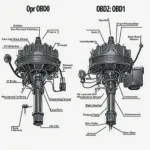The obd2 protocol iso 15765-4 can29 500 is a critical communication standard for modern vehicles. This protocol dictates how your OBD2 scanner communicates with your car’s computer, allowing you to diagnose issues and understand your vehicle’s performance. This article will delve deep into the intricacies of ISO 15765-4, exploring its importance, functionality, and practical applications.
What is OBD2 Protocol ISO 15765-4 (CAN 29/500)?
ISO 15765-4 specifies the implementation of diagnostics over a Controller Area Network (CAN) bus using a 29 bit identifier (CAN 29) at a 500 kbit/s baud rate (500). This is the most common standard for vehicles manufactured after 2008 in North America and Europe. It allows for faster and more complex data transfer compared to older protocols, enabling more sophisticated diagnostics. Think of it as the language your OBD2 scanner uses to “talk” to your car’s computer. Understanding this language is key to unlocking the wealth of information your vehicle provides.
Why is ISO 15765-4 Important?
The obd2 protocol iso 15765-4 can29 500 is the backbone of modern vehicle diagnostics. Its standardization ensures compatibility between different OBD2 scanners and a wide range of vehicle makes and models. This interoperability allows mechanics and car enthusiasts alike to access and interpret diagnostic trouble codes (DTCs), monitor sensor data, and perform various tests. Without this standardized protocol, the OBD2 world would be a chaotic mess of incompatible devices and data formats.
How Does ISO 15765-4 Work?
This protocol utilizes the CAN bus, a robust communication system within the vehicle that allows various electronic control units (ECUs) to communicate with each other. ISO 15765-4 defines how diagnostic requests and responses are packaged and transmitted over this bus. It utilizes a 29-bit identifier to specify the destination and purpose of each message, ensuring efficient and accurate communication. Imagine a busy highway with multiple lanes; the 29-bit identifier acts like an address label, directing the diagnostic message to the correct “exit” (ECU).
Key Features of ISO 15765-4
- Fast Data Transfer: The 500 kbit/s baud rate allows for rapid communication, enabling real-time data monitoring and faster diagnostic procedures.
- Multi-Frame Support: Larger messages are broken down into smaller frames, improving efficiency and reducing the risk of data corruption.
- Error Detection and Handling: Built-in mechanisms ensure data integrity by detecting and correcting transmission errors.
- Standardized Communication: Facilitates seamless communication between different OBD2 scanners and various vehicle makes and models.
Common Issues Related to ISO 15765-4
While robust, problems can sometimes arise. Wiring issues, faulty ECUs, or incompatible OBD2 scanners can disrupt communication. Troubleshooting these issues often involves checking connections, updating scanner firmware, or consulting a qualified technician.
Troubleshooting Tips for ISO 15765-4 Issues
- Check your OBD2 connector and cables for any damage or loose connections.
- Ensure your OBD2 scanner is compatible with the ISO 15765-4 protocol and your vehicle’s make and model.
- Try updating your scanner’s firmware to the latest version.
- Consult a qualified mechanic if the issue persists.
Conclusion
The obd2 protocol iso 15765-4 can29 500 plays a crucial role in modern vehicle diagnostics. Its standardized communication framework allows for efficient and reliable data transfer between OBD2 scanners and vehicles. Understanding this protocol empowers you to effectively diagnose and resolve vehicle issues, ensuring optimal performance and longevity.
FAQ
- What is the difference between CAN 29 and CAN 11? CAN 29 uses a 29-bit identifier, while CAN 11 uses an 11-bit identifier. CAN 29 is more common in newer vehicles.
- Is my car compatible with ISO 15765-4? Most vehicles manufactured after 2008 in North America and Europe use this protocol. Check your owner’s manual or consult a mechanic.
- What is a baud rate? It’s the rate at which data is transferred, measured in bits per second. ISO 15765-4 uses 500 kbit/s.
- What if my OBD2 scanner doesn’t communicate with my car? Check connections, compatibility, and update the scanner’s firmware. If problems persist, consult a mechanic.
- Why is my scanner showing “No Communication”? This could indicate a wiring issue, a faulty ECU, or an incompatible scanner.
- Can I use any OBD2 scanner with ISO 15765-4? The scanner must be compatible with this protocol.
- Where can I find more information about OBD2 protocols? OBDFree provides extensive resources and reviews on various OBD2 scanners and protocols.
For further assistance, please contact us via WhatsApp: +1(641)206-8880, Email: [email protected] or visit us at 789 Elm Street, San Francisco, CA 94102, USA. Our 24/7 customer support team is ready to help.
